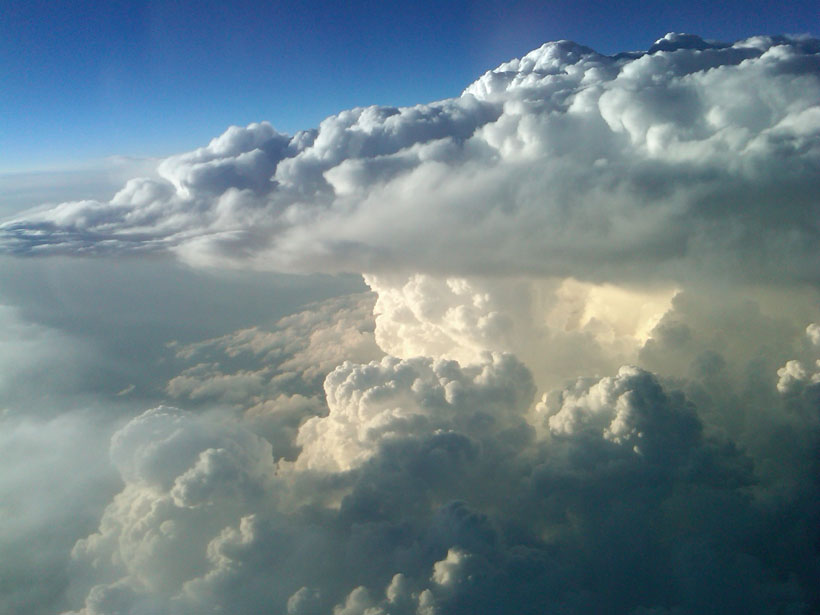Upward motions in deep thunderstorms transport trace gases and aerosols from the boundary layer to the upper troposphere and lower stratosphere (UTLS). Along the way, many complicated processes occur, including lightning and its production of nitrogen oxides (NOx), scavenging by precipitation, and chemical reactions. The consequence of these processes is high-altitude plumes of photochemically-active chemistry that produce ozone in the UTLS region, where ozone acts as a greenhouse gas.
To advance our understanding of these processes, the Deep Convective Clouds and Chemistry (DC3) field campaign was conducted over a broad area of the central US during May-June 2012. Over 300 participants, including more than 100 students and 30 postdoctoral scientists, sampled 20 storms over three regions. They used three instrumented research aircraft containing research radars, radiosondes, and total lightning detection. Data collected by DC3 are being analyzed, and results are being published in Deep Convective Clouds and Chemistry 2012 Studies (DC3), a joint special section of JGR: Atmospheres and Geophysical Research Letters.
As air near the Earth’s surface is ingested into thunderstorms, we expect most aerosols to be removed by precipitation. However, DC3 observations have shown that while over 80% of water-friendly aerosol mass is removed during transport to the upper regions of the storm, less than 50% of coarse-mode dust concentrations are, suggesting deep convection may be an efficient transport mechanism for coarse-mode dust to the upper troposphere, where these dust particles serve as ice nuclei for cirrus cloud formation and are therefore important for cloud radiation and climate effects.

With the aim of understanding and quantifying ozone production in the UT, it is important to first determine how much of the different trace gases that chemically react to form ozone are being transported to the UT via deep convection. Scientists are most interested in volatile organic compounds and NOx because they undergo chemical processes that ultimately form ozone. Using the DC3 data, scientists have quantified transport efficiencies, or conversely scavenging efficiencies, of key volatile organic compounds, such as formaldehyde and peroxides, by comparing their concentrations in the storm inflow and outflow regions. These efforts have provided new knowledge that enables us to better reproduce in numerical models the storm processes that contribute to removal of these trace gases by precipitation.
Lightning in thunderstorms plays an important role in atmospheric chemistry through its production of NOx. Analyses of DC3 storms have allowed researchers to evaluate and update existing parameterization schemes of flash rate used in cloud-resolving chemical transport models. In addition to flash rate, the three-dimensional flash size has been recognized to be relevant to the production of NOx. As a result of DC3 observations, the production of NOx from lightning has been refined, and scientists are beginning to connect these NOx production rates to storm and lightning characteristics. This will improve representations in chemistry-climate models that project future climate and air quality.
A surprising result was encountered during DC3: the cloud-scale stratosphere-troposphere exchange caused by thunderstorm dynamics.
DC3 scientists observed high ozone concentrations in the UT as a result of the deep convection. Estimates of ozone production in convective outflows with and without wildfire smoke underscore the observation that more lightning-produced NOx creates more ozone. Although we expect ozone to be formed in the UT convective outflow plumes, a surprising result was encountered during DC3: the cloud-scale stratosphere-troposphere exchange caused by thunderstorm dynamics. Measurements found stratospheric ozone alongside storm anvils, even wrapping around the anvil in one case, bringing high ozone concentrations into the UT. These studies show that high ozone concentrations in the UT are a result of both in situ chemical production in convective outflow plumes and mixing from the stratosphere as generated by deep convection penetrating the tropopause.
In addition to stratospheric air being mixed into the UT, some of the DC3 storms were shown to transport water vapor into the stratosphere, where it may have important impacts on radiation and climate. Analysis of these storms has led to the hypothesis that weakened stability associated with double-tropopause environments facilitates convective injection deep into the stratosphere.
In summary, analyses of DC3 data have shown that thunderstorms affect the composition of the UTLS region by transporting air rich in water vapor, volatile organic compounds, and aerosols from near the Earth’s surface to the UTLS, by producing NOx from lightning, and by causing mixing between the troposphere and stratosphere. These processes link thunderstorms to climate via their impact on aerosols, water vapor in the stratosphere, and ozone as a greenhouse gas.
Mary Barth, Guest Editor of Special Section Deep Convective Clouds and Chemistry 2012 Studies (DC3), and Chidong Zhang, Editor, JGR: Atmospheres
Citation:
Barth, M.,Zhang, C. (2016), Connecting thunderstorms and climate through ozone, Eos, 97, https://doi.org/10.1029/2018EO051761. Published on 05 May 2016.
Text © 2016. The authors. CC BY-NC-ND 3.0
Except where otherwise noted, images are subject to copyright. Any reuse without express permission from the copyright owner is prohibited.

